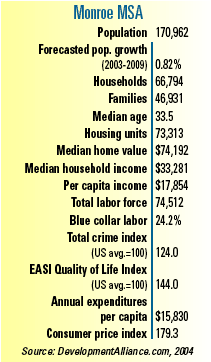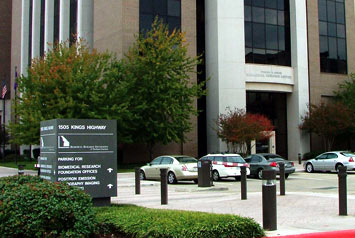
JANUARY 2005
Louisiana: Why Industry Is Moving Back to the Bayou State
Sir, the Governor's
on the Phone
First Among Equals
Education-Industry Partnership
Port Gets Retooling for 21st Century Commerce (sidebar)
Bringing the
Students Home
Blanco: Ethics
Is Job One
Shreveport's Aerospace Industry Gains Altitude (sidebar)
GM Plant Hums Along
How Louisiana
Beat Ohio
Education Inroads
Foundation Gives Biotech a Boost
Enhanced State Economic Development Portal to Debut (sidebar)
Industry Clusters
Gain Traction
Transport Complex Would Reclaim Louisiana's 'Gateway to Latin America' Status (sidebar)
Container-on-Barge
Is Key
Energy Industry
in Transition
Request Information

Foundation Gives
Biotech a Boost
Biotech a Boost
Higher education is also where much of the state's
emerging biotechnology industry is taking shape. Anchoring a biomedical
hub in northwest Louisiana, for instance, is Louisiana State University
Health Sciences Center in Shreveport, a leading teaching and research
hospital.
Capitalizing on the research potential such a facility offers, the Biomedical
Research Foundation of Northwest Louisiana (BRF) is developing the InterTech
Science Park adjacent to the hospital for start-up companies in the
life sciences sector. The park already has a newly constructed biomanufacturing
facility available for occupancy, and a commercial wet lab incubator
called BioSpace1 is under construction.
In June 2004, Red River Pharma, a locally based contract pharmaceutical research and development company opened a new manufacturing facility at the park. The company had been manufacturing products outside Louisiana until opening operations at InterTech.
BRF's role is to help launch companies in the bioscience field by making resources and space available to entrepreneurs and others seeking to commercialize research. "Our mission is focused on putting a circle on the map around northwest Louisiana as a regional technology center that would be nationally recognized," says Dennis Lower, vice president for planning and development and director of InterTech Science Park.
Several north Louisiana universities have formed the Consortium for Education, Research and Technology (CERT) to support the corporate needs of InterTech tenants. BRF helped organize the consortium early on. Most science parks in the U.S. are located adjacent to major land grant universities, which is not the case with InterTech in Shreveport. "Because there is no land grant university here, we created one," says John F. Sharp, BRF's president. "We did it by bringing together the 10 institutions that were here. We created a virtual research university and campus so we can take young, private start-ups and link them to whatever they need. They can find the support they need in one of those institutions, or we guide them to where they can find that support within the consortium. The private sector values that," adds Sharp, "and the consortium members are finding they are benefiting as well in terms of collaborative research and inter-institutional grant applications. It's an important part of the infrastructure here."
|
|
| The Biomedical Research Foundation of Northwest Louisiana, headquartered at Louisiana State University Health Sciences Center in Shreveport, is developing a science park for start-up companies resulting from life sciences research and development being done at any of 10 universities in northern Louisiana. |
In June 2004, Red River Pharma, a locally based contract pharmaceutical research and development company opened a new manufacturing facility at the park. The company had been manufacturing products outside Louisiana until opening operations at InterTech.
BRF's role is to help launch companies in the bioscience field by making resources and space available to entrepreneurs and others seeking to commercialize research. "Our mission is focused on putting a circle on the map around northwest Louisiana as a regional technology center that would be nationally recognized," says Dennis Lower, vice president for planning and development and director of InterTech Science Park.
 |
Several north Louisiana universities have formed the Consortium for Education, Research and Technology (CERT) to support the corporate needs of InterTech tenants. BRF helped organize the consortium early on. Most science parks in the U.S. are located adjacent to major land grant universities, which is not the case with InterTech in Shreveport. "Because there is no land grant university here, we created one," says John F. Sharp, BRF's president. "We did it by bringing together the 10 institutions that were here. We created a virtual research university and campus so we can take young, private start-ups and link them to whatever they need. They can find the support they need in one of those institutions, or we guide them to where they can find that support within the consortium. The private sector values that," adds Sharp, "and the consortium members are finding they are benefiting as well in terms of collaborative research and inter-institutional grant applications. It's an important part of the infrastructure here."
